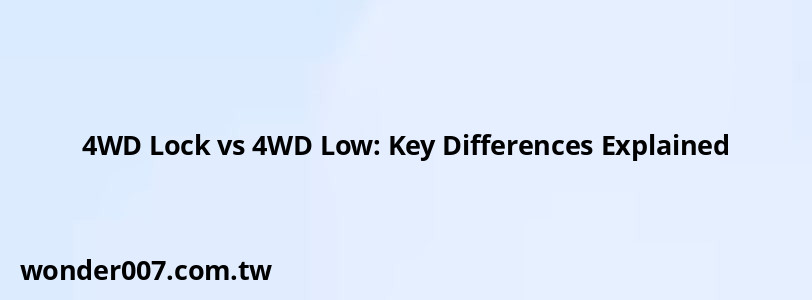4WD Lock vs 4WD Low: Key Differences Explained

4WD Lock and 4WD Low
4WD Lock and 4WD Low are two different four-wheel drive modes found in many off-road vehicles. While both provide increased traction, they serve different purposes and operate in distinct ways.
4WD Lock
4WD Lock, also known as 4WD High, is designed for use on slippery surfaces at normal driving speeds. In this mode, the transfer case locks, distributing power equally between the front and rear axles. This provides improved traction without significantly reducing vehicle speed.
Key features of 4WD Lock:
- Suitable for speeds up to highway limits
- Used on slippery roads, snow, or light off-road conditions
- Maintains normal gear ratios
4WD Low
4WD Low, on the other hand, is specifically designed for low-speed, high-torque situations. This mode engages a lower gear ratio in the transfer case, significantly increasing torque to all four wheels.
Key features of 4WD Low:
- Used for extreme off-road conditions or when stuck
- Provides maximum torque for climbing or descending steep grades
- Typically limited to speeds under 25 mph
When to Use Each Mode
Understanding when to use each mode is crucial for optimal vehicle performance and safety.
4WD Lock Usage
Use 4WD Lock when:
- Driving on snow-covered roads
- Navigating muddy terrain at moderate speeds
- Traversing sandy beaches
4WD Low Usage
Engage 4WD Low when:
- Rock crawling or navigating extremely rough terrain
- Climbing or descending very steep hills
- Pulling heavy loads at low speeds
Common Misconceptions
There are several misconceptions about 4WD Lock and 4WD Low that need clarification:
1. Locking differentials: Neither 4WD Lock nor 4WD Low automatically locks the differentials. They only affect the transfer case.
2. Speed limitations: While 4WD Low has strict speed limits, 4WD Lock can be used at higher speeds, though it's not recommended for prolonged use on dry pavement.
3. Traction on all surfaces: Both modes improve traction, but they don't guarantee it on all surfaces. Proper tire selection and driving technique are still crucial.
Conclusion
Both 4WD Lock and 4WD Low serve important roles in off-road and adverse condition driving. Understanding their differences and appropriate usage scenarios can significantly enhance your vehicle's capabilities and your driving experience.
FAQs About 4WD Lock vs 4WD Low
- Can I switch between 4WD Lock and 4WD Low while driving?
Most vehicles require you to stop or be moving very slowly to switch between these modes. Always consult your vehicle's manual for specific instructions. - Does using 4WD Lock or 4WD Low improve fuel efficiency?
No, both modes typically decrease fuel efficiency due to increased drivetrain resistance. Use them only when necessary for traction. - Are 4WD Lock and 4WD Low the same in all vehicles?
While the basic principles are similar, implementation can vary between manufacturers. Always refer to your vehicle's manual for specific details and usage guidelines.
Related Posts
-
2005 Dodge Ram 1500 EVAP System Explained
30-01-2025 • 129 views -
2WD Ford Ranger Front Suspension Diagram Explained
26-01-2025 • 176 views -
How To Remove Spare Tire Lock Without Key: Effective Methods
28-01-2025 • 138 views -
Alfa Romeo Giulietta: Dashboard Warning Lights Explained
26-01-2025 • 161 views -
Steering Wheel Lock: Why It Happens When Parked
26-01-2025 • 199 views
Latest Posts
-
Power Steering Fluid Leak On Passenger Side
01-02-2025 • 457 views -
2015 Chevy Traverse AC Recharge Port Location
01-02-2025 • 409 views -
Rear Brake Caliper Piston Won't Compress
01-02-2025 • 356 views -
How To Turn Off Paddle Shifters Mercedes
01-02-2025 • 377 views -
Are O2 Sensors Covered Under Warranty
01-02-2025 • 376 views
Popular Posts
-
EPC Light: Understanding Causes and Solutions
26-01-2025 • 1053 views -
V12 Engine Costs: What You Need to Know
26-01-2025 • 679 views -
EPC Warning Light: What It Means for Your Vehicle
27-01-2025 • 630 views -
Power Steering and ABS Light On: Causes and Solutions
27-01-2025 • 643 views -
Hino Warning Lights: Understanding Dashboard Alerts
26-01-2025 • 765 views
